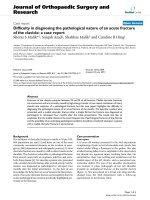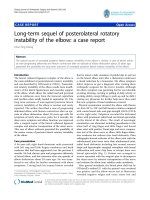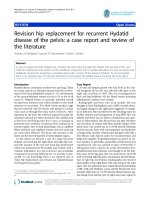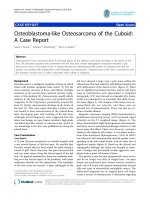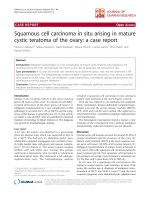Surgical management of lymphoma in a dog - A case report
Bạn đang xem bản rút gọn của tài liệu. Xem và tải ngay bản đầy đủ của tài liệu tại đây (128.24 KB, 3 trang )
Int.J.Curr.Microbiol.App.Sci (2018) 7(8): 4419-4421
International Journal of Current Microbiology and Applied Sciences
ISSN: 2319-7706 Volume 7 Number 08 (2018)
Journal homepage:
Original Research Article
/>
Surgical Management of Lymphoma in a Dog- A Case Report
Rakesh Kumar1, Gaurav Kumar2*, Rajeev Kumar3 and Vinay Yadav
1
Veterinary Surgeon, GVH Dublana (Mahender Garh), Department of Animal Husbandry and
Dairying, Haryana123001, India
2
Department of Veterinary Surgery and Radiology, LUVAS, Hisar 125004
3
Veterinary Surgeon, GVH Deroli Ahir (Mahender Garh), Department of Animal Husbandry
and Dairying, Haryana 123001, India
2
Department of Veterinary Gynaecology and Obstetrics, LUVAS, Hisar 125004
*Corresponding author
ABSTRACT
Keywords
Surgical
Management,
Lymphoma,
Histopathological
examination
Article Info
Accepted:
26 July 2018
Available Online:
10 August 2018
A male Dog, breed German Shepherd age 3yrs approximate was presented
with the history of anorexia, weight loss, muscular weakness, depression,
polydipsia, polyuria and bilateral peripheral lymphadenopathy at the
hospital. The blood picture of the animal showed normal blood counts as
well as normal LFT and KFT. On histopathological examination of the
tumorous growth extracted from the lymph node clearly showed NonHodgkin’s Lymphoma that was surgically removed successfully.
Introduction
Lymphoma
is
the
most
common
hematopoietic neoplasm in the dogs
representing 7-9 percent of all malignant
neoplasms (Hammer and Couto, 1991). The
annual incidence has been estimated at 24 per
100000 dogs (Dorn et al., 1970), although a
lower incidence has been reported in other
surveys (Back-green, 1965; Parodi et al.,
1968). Dogs are often asymptomatic, but 20-
40% of dogs will have anorexia, lethargy,
fever weight loss, vomiting, diarrhea and
melena (Vail et al., 2001). The clinical signs
of canine lymphoma usually reflect the
anatomical site affected, in this particular case
there is excessive enlargement of pre-scapular
lymph nodes, weight loss, anorexia,
depression, polydipsia and polyuria. The main
purpose of this study was to report on this type
of canine lymphoma which is rare in every
day practice.
4419
Int.J.Curr.Microbiol.App.Sci (2018) 7(8): 4419-4421
History and Observations
A 3 years German Shepherd male Dogwas
presented to the Government Veterinary
Hospital, Dublana Distt Mahender Garh,
Haryana with the history of anorexia, weight
loss,
muscular
weakness,
depression,
polydipsia, polyuria etc. Body temperature
was subnormal (99o F). On physical
examination both the pre-scapular lymph
nodes were enlarged extensively. On aseptic
lymph node centesis, blood mixed aspirate
was able to be collected with a sixteen-gauze
sterile needle and syringe. Complete blood
examination of the dog was conducted along
with Liver function tests (LFT) and Kidney
function test (KFT) and complete Urine
analysis to assess the changes and
physiological status of different visceral
organs.
Treatment and Discussion
The complete
blood count
showed
lymphocytosis but LFT as well as complete
Urinalysis showed normal report however
slight increase in blood urea levels was
observed
(Table
1).
History,
site,
subcutaneous location, round shape of the
growths made it suspect as benign growth. It
indicated that the tumor is non-malignant in
nature or metastasis is not happened yet i.e.
early detection of the tumor.
Table.1 Hemato-biochemical picture of the patient
Parameters
1) TLC
2) Neutrophils
3) Lymphocytes
4) Eosinophils
5) Serum bilirubin
6) Serum creatinine
7) Blood urea nitrogen
8) ALT
9) AST
10) ESR
Obtained value
12,600/ cu.mm.
74%
22%
4%
0.6 mg/dL
1.2 mg/dL
20 mg/dL
23U/L
31U/L
5mm/hr
Many types of treatment have been proposed
for canine Non-Hodgkin Lymphoma but the
most commonly used is chemotherapy. Single
agent protocols were initially used (i.e.
Doxorubicin,
Cyclophosphamide),
but
nowadays multiple agent chemotherapy is the
most common approach to NHL and canine
Non-Hodgkin
Lymphoma.
Currently,
response to chemotherapy in multicentric Bcell canine Non-Hodgkin Lymphoma is about
80%. Unfortunately, it is not curative but
induces remission with a good quality of life
for dogs. The median survival in B-cell
canine Non-Hodgkin Lymphoma in treated
dogs is about 12 months (Gavazza et al.,
2013). So, surgical excision of the growths
Normal range
5100-14100/cu.mm.
58-85%
8-21%
0-9%
0-0.3 mg/dL
0.5-1.7 mg/dL
8-28 mg/dL
10-109U/L
13-15U/L
0-6mm/hr
was opted for the treatment. Both Prescapular lymph nodes of the dog were
surgically removed aseptically under general
anesthesia using Inj. xylazine hydrochloride
as sedative @ 0.5mg per kg bodyweight
intramuscularly. Anesthesia was maintained
by ketamine @ 5mg per kg body weight and
midazolam @ 0.25mg per kg body weight
combination as per dosage formulation given
by Fossum (2007).
A Part of the growth was sent for
histopathological examination for the
evidence of any type of tumorous growth.
However, the other reports were normal and
there was no evidence of malignancy. The
4420
Int.J.Curr.Microbiol.App.Sci (2018) 7(8): 4419-4421
owner was advised to keep the dog on Inj.
Ceftriaxone and Tazobactum combination @
20mg per kg bodyweight intramuscularly, Inj.
Meloxicam @ 0.3mg per kg bodyweight
intramuscularly, Inj. Mecovet XL 2 ml
intramuscularly,
Inj.
Vit-C
2
ml
intramuscularly, all these for 5 Days and
Anti-Septic Dressing Daily for a faster
recovery. No complication or infection was
found post-operatively. Sutures were removed
after 8 days and the dog was apparently
healthy. Surgically resected mass was incised
and the cut surface grossly appeared greyish
brown and soft in nature. Histopathological
study of the growth extracted clearly revealed
the presence of non-Hodgkin’s lymphoma
(diffuse, large cell).
The haemogram in canine lymphoma is not
usually diagnostic (Madewell and Theilen,
1987).
Neutrophilic
leukocytosis
and
lymphocytosis are common findings (Couto,
1985). The clinical staging of these canine
lymphoma cases based on WHO criteria
(Owen, 1980) could fit in stage-I. Nowadays,
the ultimate therapy for both humans and
dogs is vaccine treatment. In recent times the
genetic vaccine Targeting Dog Telomerase
(dTERT), based on Ad/DNA-EP technology
(Adenovirus and DNA electroporation), has
been found to induce strong immune
responses and increased overall survival of
dogs affected by B-cell lymphoma in
comparison with controls when combined
with a COP (corticosteroids, vincristine, and
cyclophosphamide) chemotherapy regimen.
No adverse effects that might be attributed to
treatment have been observed in any patient.
A dTERT-specific immune response has been
induced in almost all the treated animals
(Gavazza et al., 2013).
References
Backgreen, A.W. (1985). Lymphatic Leukosis
in
Dogs.
Acta
Veterinaria
Scandinavica, 6: (Supplement), 1.
Couto, C.G. (1985). Canine Lymphomas:
Something old, Something New.
Compendium of Continuing Education
7: 291-98.
Fossum, T.W. (2007) Small Animal Surgery,
3rd Edn, Mosby Elsevier, p 307-10.
Gavazza, A., Bocci, G. and Giorgi, G. (2013).
Treatment of canine lymphoma as a
model for humans. Journal of Clinical
and Experimental Pharmacology.
3:e120.
Hammar, S.A. and Couto, C.G. (1991)
Lymphadenopathy and splenomegaly.
In: small Animal Medicine. Ed D.A.
Allen, J.B. Lippincott, Philadelphia.
Pp 156.
Madewell, R.B. and Theilen, H.G. (1987).
Tumors of the Urogenital tract. In:
Veterinary Cancer Medicine. 2nd edn.
Lea and Febiger, Philadelphia. Pp.
567-600.
Owen, L. (1980). WHO Clinical Staging.
Geneva, World Health Organization,
VPH/CMO/20. p 47.
Parodi, A., Wyers, M. and Paris, J. (1986).
Incidence of canine lymphoid leucosis.
Age, breed and sex distribution, results
of necroscopic survey. Bibliotheca
Haematologica.30: 263-267.
Vail, D.M., MacEwen, E.G. and Young,
K.M.(2001). Canine lymphoma and
lymphoid leukemias. In: Withrow, S.J.
and MacEwen, E.G. (eds): Small
Animal Clinical Oncology (ed 3). New
York, Saunders, pp. 558-590.
How to cite this article:
Rakesh Kumar, Gaurav Kumar, Rajeev Kumar and Vinay Yadav. 2018. Surgical Management
of Lymphoma in a Dog- A Case Report. Int.J.Curr.Microbiol.App.Sci. 7(08): 4419-4421.
doi: />4421
